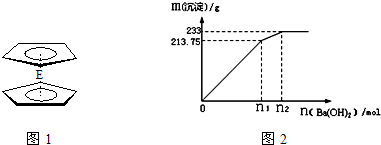A、J是日常生活中常见的两种金属,这两种金属和NaOH组成原电池,A作负极;F常温下是气体,各物质有以下的转化关系(部分产物及条件略去).

请回答以下问题:
(1)写出原电池的负极反应方程式______.
(2)常温时pH=12的C溶液中,溶质的阳离子与溶质的阴离子浓度之差为______(写出计算式);相同条件下,等浓度的C溶液与CH3COONa溶液中,C的阴离子与CH3COO-浓度的大小关系:前者______后者(用“>”、“<”或“=”表示).
(3)金属A的氯化物沸点较低,又易升华,能否电解这种熔融氯化物来生产A?______.原因是______.
(4)写出A→J反应的化学方程式______.

(5)由J制备的J(C5H5)2的结构如图1,其中氢原子的化学环境完全相同.但早期人们却错误地认为它的结构为:

.核磁共振法能够区分这两种结构.在核磁共振氢谱中,正确的结构有______
种峰,错误的结构有______种峰.
(6)含A元素的某盐X常做净水剂,X做焰色反应时,透过钴玻璃观察火焰呈紫色.500mLX的溶液与Ba(OH)2反应生成沉淀的质量
与加入Ba(OH)2物质的量的关系如图2:请回答:X晶体的俗名为______;其溶液的物质量浓度为______mol/L.
:(1)题中H→A为工业冶炼金属铝,A→J为铝热反应,为推断题的突破口,依次可知C→E→H→A→J的转化是中学化学中常见反应,为AlO2-→Al(OH)3→Al2O3→Al→Fe之间的转化,该原电池是铝做负极,铁做正极,电解质溶液为NaOH,可以推知:A为Al,C为NaAlO,E为Al(OH)3,H为Al2O3,J为Fe,M为FeS,原电池中,Al做负极被氧化,在碱性溶液中生成AlO2-,电极反应式为:Al+4OH--3e-=AlO2-+2H2O,故答案为:Al+4OH--3e-=AlO2-+2H2O;
(2)溶液C为NaAlO2,根据溶液呈电中性,即c(AlO2-)+c(OH-)=c(Na+)+c(H+)可知:c(Na+)-c(AlO2-)=c(OH-)-c(H+)=10-2-10-12 mol/L;
故答案为:10-2-10-12 mol/L或c(OH-)-c(H+);
(3)金属A的氯化物为AlCl3,为共价化合物在熔融状态下不导电,
故答案为:否;因为A的氯化物熔沸点低,据此判断它的晶体为分子晶体,在熔融态时不电离,不能被电解;
(4)反应A→J为铝热反应,反应为:Fe2O3+2Al
2Fe+Al2O3 故答案为:Fe2O3+2Al 高温 .
2Fe+Al2O3 高温 .
(5)制备的J(C5H5)2的结构如图1,其中氢原子的化学环境完全相同,核磁共振氢谱中峰值为1,结构为:

结构中含有三种位置的氢原子,所以核磁共振氢谱中峰值为3;故答案为:1; 3
(6)含A元素的某盐X常做净水剂,X做焰色反应时,透过钴玻璃观察火焰呈紫色,说明盐中含有铝元素和钾元素,为明矾,俗称为明矾或白矾;
根据反应计算:
Ba2++SO42-═BaSO4
1mol 233g
n 233g
则n=1mol,根据SO42-离子的守恒可知500mLKAl(SO4)2的溶液中含有溶质的物质的量为0.5mol,
故浓度为:
=1mol/L,故答案为:明矾或白矾;1mol/L.0.5mol 0.5L
